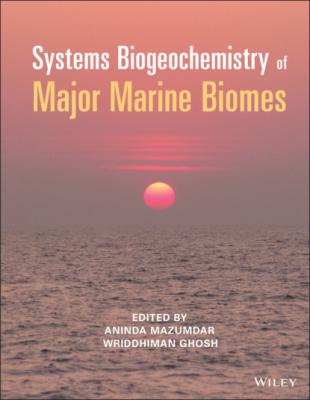Systems Biogeochemistry of Major Marine Biomes. Группа авторов
Чтение книги онлайн.
Читать онлайн книгу Systems Biogeochemistry of Major Marine Biomes - Группа авторов страница 46
 D. and LutherIII, G.W. (2007). Chemistry of iron sulfides. Chemical Reviews 107 (2): 514–562. https://doi.org/10.1021/cr0503658
D. and LutherIII, G.W. (2007). Chemistry of iron sulfides. Chemical Reviews 107 (2): 514–562. https://doi.org/10.1021/cr0503658119 Riedinger, N., Brunner, B., Krastel, S. et al. (2017). Sulfur cycling in an iron oxide‐dominated, dynamic marine depositional system: the Argentine Continental Margin. Frontiers in Earth Science 5. https://doi:10.3389/feart.2017.00033.
120 Risgaard‐Petersen, N., Revil, A., Meister, P. et al. (2012). Sulphur, iron and calcium cycling associated with natural electric currents in marine sediment. Geochimica et Cosmochimica Acta. 92: 1–13. https://doi.org/10.1016/j.gca.2012.05.036
121 Roden, E.E. and Lovley, D.R. 1993. Dissimilatory Fe(III) reduction by the marine microorganism, Desulfuromonas acetoxidans. Applied Environmental Microbiology 59 (3): 734–742.
122 Saha, R., Saha, N., Donofrio, R.S. et al. (2012). Microbial siderophores: a minireview. Journal of Basic Microbiology 53 (4): 303–317. https://doi.org/10.1002/jobm.201100552
123 Saltikov, C.W., Cifuentes, A., Venkateswaran, K. et al. (2003). The ars detoxification system is advantageous but not required for As(V) respiration by the genetically tractable Shewanella species strain ANA‐3. Applied and Environmental Microbiology 69(5): 2800–2809. doi:10.1128/AEM.69.5.2800–2809.2003
124 Sanjana, T.K., Ghangrekar, M.M. and Mitra, A. (2016). In situ bioremediation using sediment microbial fuel cell. Journal of Hazardous, Toxic and Radioactive Waste 21 (2): 04016022. doi:10.1061/(asce)hz.2153‐5515.0000339
125 Santos, T.C., Silva, M.A., Morgado, L. et al. (2015). Diving into the redox properties of Geobacter sulfurreducens cytochromes: a model for extracellular electron transfer. Dalton Transactions 44 (20): 9335–9344. doi:10.1039/c5dt00556f
126 Satomi, M. 2014. The family Shewanellaceae. In: The Prokaryotes (eds. E. Rosenberg, E.F. DeLong, S. Lory et al.), 597–625. Berlin, Heidelberg: Springer. https://doi.org/10.1007/978‐3‐642‐38922‐1_226
127 Schauer, R., Petersen, N.R., Kjeldsen, K.U. et al. (2014). Succession of cable bacteria and electric currents in marine sediments. ISME Journal 8 (6): 1314–1322. https://doi.org/10.1038/ismej.2013.239
128 Scheller, S., Yu, H., Chadwick, G.L., McGlynn, S.E., Orphan, V.J. (2016). Artificial electron acceptors decouple archaeal methane oxidation from sulfate reduction. Science351: 6274 703–707.
129 Schulz, H.D. and Zabel, M. ed. (2006). Marine Geochemistry, 2e. Berlin: Springer.
130 Shi, L., Squier, C., Zachara, J.M. et al. (2007). Respiration of metal (hydr)oxides by Shewnaella and Geobacter: a key role for multihaem c‐type cytochromes. Molecular Microbiology 65 (1): 12–20. https://doi.org/10.1111/j.1365–2958.2007.05783.x
131 Shi, L., Dong, H., Reguera, G. et al. (2016). Extracellular electron transfer mechanisms between microorganisms and minerals. Nature Reviews Microbiology14 (10): 651–662. doi:10.1038/nrmicro.2016.93
132 Sinkko, H., Lukkari, K., Jama, A.S. et al. (2011). Phosphorus chemistry and bacterial community composition interact in brackish sediments receiving agricultural discharges. PLoS One 6 (6): e21555. https://doi.org/10.1371/journal.pone.0021555
133 Sivan, O., Shusta, S.S., Valentine, D.L. (2016). Methanogens rapidly transition from methane production to iron reduction. Geobiology 14 (2): 190–203. https://doi.org/10.1111/gbi.12172
134 Sleep, N.H. (2018). Geological and geochemical constraints on the origin and evolution of life. Astrobiology 18 (9): 1199–1219. https://doi.org/10.1089/ast.2017.1778
135 Slobodkina, G.B., Kolganova, T.V., Chernyh, N.A. et al. (2009). Deferribacter autotrophicus sp. nov., an iron (III)‐reducing bacterium from a deep‐sea hydrothermal vent. International Journal of Systematic and Evolutionary Microbiology 59 (6): 1508–1512. https://doi.org/10.1099/ijs.0.006767–0
136 Smith, H., Abuyen, K., Tremblay, J. et al. (2018). Genome sequence of Geothermobacter sp. strain HR‐1, an iron reducer from the Lō ‘ihi Seamount Hawai’i. Genome Announcements 6 (21): e00339–18. doi:10.1128/genomeA.00339–18
137 Stapleton, R., Sabree, Z., Palumbo, A.V. et al. (2005). Metal reduction at cold temperatures by Shewanella isolates from various marine environments. Aquatic Microbial Ecology 38 (1): 81–91. doi:10.3354/ame038081
138 Subramanian, P., Pirbadian, S., El‐Naggar, M.Y.et al. (2018). Ultrastructure of Shewanella oneidensis MR‐1 nanowires revealed by electron cyrotomography. Proceedings of the National Academy of Sciences 115 (14): E3246–E3255. https://doi:10.1073/pnas.1718810115
139 Tebo, B.M. and Obraztsova, A.Y. (1998). Sulfate‐reducing bacterium grows with Cr(VI), U(VI), Mn(IV) and Fe(III) as electron acceptors. FEMS Microbiology Letters 162 (1): 193–199. https://doi.org/10.1111/j.1574–6968.1998.tb12998.x
140 Timmers, P.H.A., Welte, C.U., Koehorst, J.J. et al. (2017). Reverse methanogenesis and respiration in methanotropic archaea. Archaea, 17: 1–22. https://doi.org/10.1155/2017/1654237
141 Thang, N.M., Brüchert, V., Formolo, M. et al.(2013). The impact of sediment and carbon fluxes on the biogeochemistry of methane and sulfur in littoral Baltic Sea sediments (Himmerfjärden, Sweden). Estuar. Coast, 36 (1): 98–115. https://doi.org/10.1007/s12237–012–9557–0
142 Toulza, E., Tagliabue, A., Blain, S. et al. (2012). Analysis of the global ocean sampling (GOS) project trends in iron uptake by surface ocean microbes. PLoS One, 7(2): e30931. https://doi.org/10.1371/journal.pone.0030931
143 Tully, B., Savalia, P., Abuyen, K. et al. (2017). Genome sequence of Geothermobacter sp. strain EPR‐M, a deep‐sea hydrothermal vent iron reducer. Genome Announcements 5 (23): e00424–17. doi:10.1128/genomeA.00424–17
144 Turick, C.E., Louis, S.T. and Caccavo Jr, F. (2002). Melanin production and use as a soluble electron shuttle for Fe(III) oxide reduction and as a terminal electron acceptor by Shewanella algae BrY. Applied and Environmental Microbiology 68 (5): 2436–2444. doi:10.1128/AEM.68.5.2436–2444.2002
145 Vargas, M., Kashefi, K., Blunt‐Harris, E.L. et al. (1998). Microbiological evidence for Fe(III) reduction on early Earth. Nature 395 (6697): 65.
146 Vargas, M., Malvankar, N.S., Tremblay, P.L. et al. (2013). Aromatic amino acids requires for pili conductivity and long‐range extracellular electron transport in Geobacter sulfurreducens. mBio 4(2): e00105–13. doi:10.1128/mBio.00105–13
147 Venkateswaran, K., Dollhopf, M.E., Aller, R. et al. (1998). Shewanella amazonensis sp. nov., a novel metal‐reducing facultative anaerobe from Amazonian shelf muds. International Journal of Systematic and Evolutionary Microbiology 48